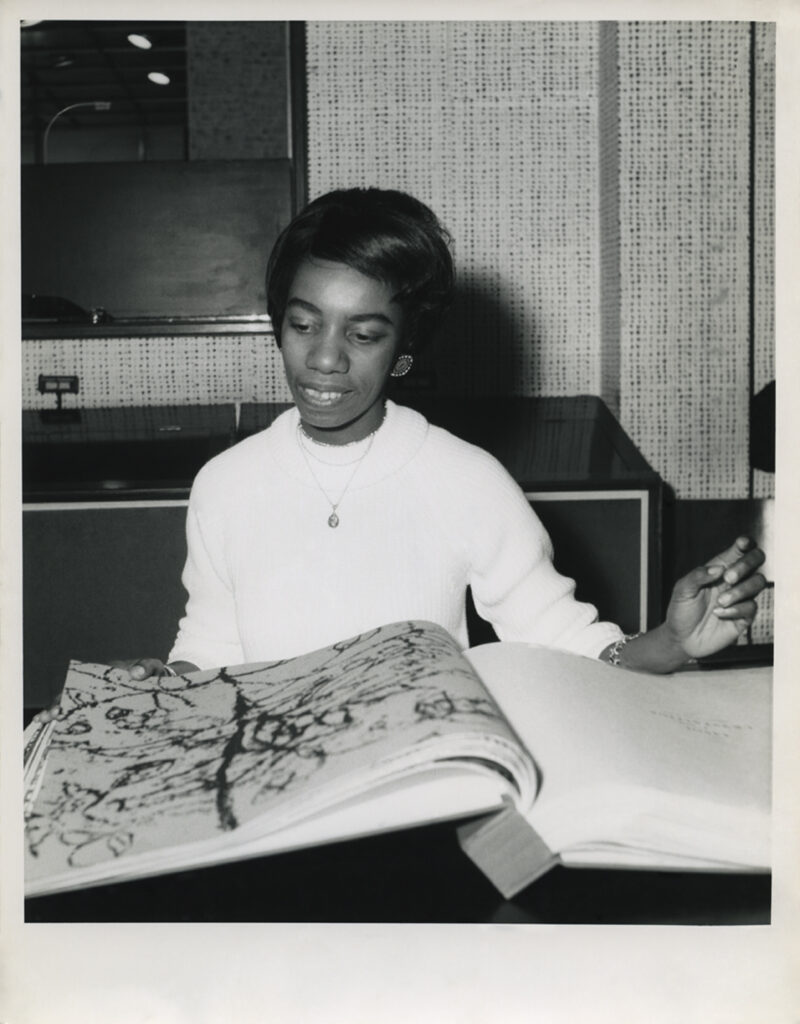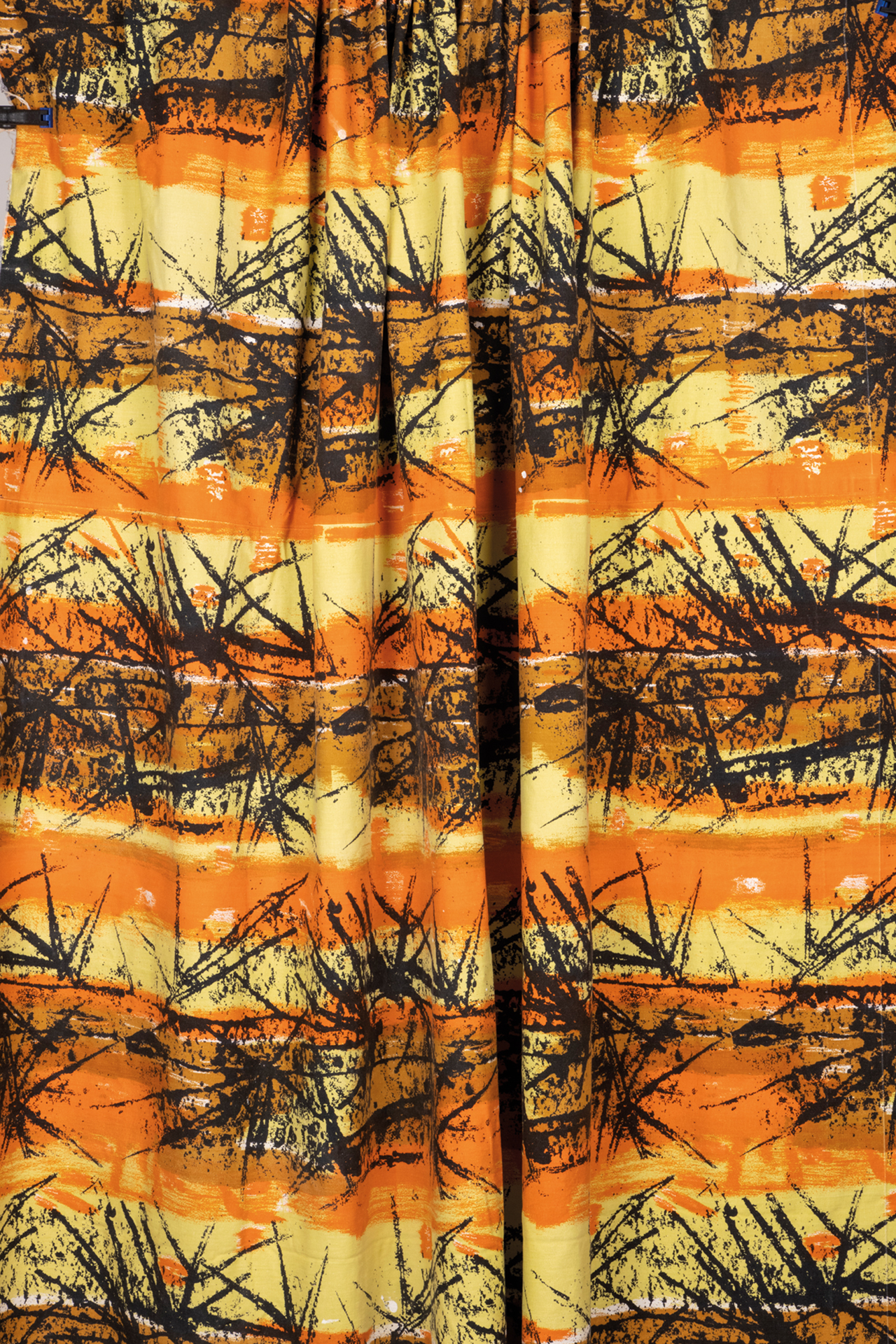Power colour
The vibrancy of Althea McNish’s textiles injected some much needed colour into post-war Britain. But black was the colour that held the most power for her
In 1965 a major fashion breakthrough owed credit to Manchester. It’s not that the city lays some unknown claim to the daring hemline of the miniskirt. Nor was it the secret birthplace of the hippy. Instead, its origin was in the unlikely confines of Manchester University’s chemistry labs.
More than two decades before, seminal research in the labs by Accrington-born John Rex Whinfield led to the creation of a new polyester fibre Terylene. When chemical company ICI decided to produce it for the mass market in the mid-1960s, it was smart enough to hire someone to inject it with some much-needed colour.
“Althea McNish was viewed as the perfect designer to promote it,” says Rowan Bain, principal curator at London’s William Morris Gallery. “She worked with the manufacturers and garment makers to ensure the scale of the pattern would match potential clothing designs. This direct conversation between the three was something that had never been done before in the fashion industry.”
McNish said the result was a “really first class and unusual fabric”, the first synthetic one to take the strong colour she was known for.
Born in Port of Spain, Trinidad,in 1924, McNish moved to the UK with her family in 1950. After gaining a scholarship for a postgraduate degree in textiles at the Royal College of Art, she went on to become the first Black British textile designer to gain an international reputation. Her work on Terylene is just one aspect of a wide-ranging retrospective of her work on show at the Whitworth Art Gallery, on tour from the Morris Gallery.
“McNish matched post-war Britain’s readiness for more vibrant, colourful fabrics,” says Bain. “The range of designs for some of the very best companies, such as Heals, Liberty and John Lewis, demonstrate her exceptional skill and technical versatility. She had an innate understanding of how to interpret different patterns, shapes and colours by ‘tropicalising’ the designs, and how best these could be applied to specific fabrics.”
Aptly called Colour is Mine, the exhibition demonstrates the designer’s innovative approach to colour, highlighted in her work for companies such as Danasco, which was creating new textiles for the British consumer that championed Scandinavian design.
“Her design Orina is an early example of McNish using playful abstraction in her designs,” says Bain. “Painterly horizontal stripes are overlaid with scratchy black flower motifs. She referred to the use of black as a statement or ‘power colour’. She said: ‘Grey is a colour I would never use on my palette. Black! Because it has power in it to do for me what I want.’”
Although McNish described herself as a “citizen of the world” and took inspiration from many different cultures, her Trinidadian identity remained clear in her choice of colours and botanical forms for her designs. She once said that she took the flowers of the English countryside and transformed them into “Caribbean flamboyance”.
The daughter of a journalist and a seamstress, McNish was well educated, grew up financially secure and described her childhood as “carefree”. Her parents encouraged her artistic talents and she became a junior member of the Trinidad Art Society and friends with notable artists such as Sybil Atteck and Mahmoud Pharouk Alladin, sitting, she said, “for them all”.
Associated with the Caribbean Art Movement of the 1960s, she considered herself an artist in the traditional sense and, while enjoying professional success as a designer, continued to exhibit her paintings and designs. In December 1958, she had a two week show at the Woodstock Gallery in London, an exhibition in Rome in 1959, and various others in Trinidad and London throughout her life.
“She often referred to her textiles themselves as paintings on cloth, and towards the end of her career she did less traditional textiles and more paintings on large canvasses,” says Bain. “We have samples in the exhibition such as Casino (1990), and also a range of botanical watercolours (2000). McNish refused to be labelled as a textile designer, and said she was a designer who could do anything.”

Alongside McNish’s work, Colour is Mine also features the artist’s friends and contemporaries including Atteck, tutors Edward Bawden and Eduardo Paolozzi, fellow members of the Caribbean Artist Movement Ronald Moody and Winston Branch, and protégé Leslee Wills. Hull-born Shirley Craven, regarded as one of the most gifted textile designers of her generation and design director at Hull Traders, is also spotlighted.
Alongside this display of the best of post-war British design is a contemporary installation by Nana Biamah-Ofosu and Bushra Mohamed of architecture and design practice Studio Nyali. The pair have created The Bachelor Girl of Today for the Whitworth, an updated interpretation of a 1966 commission McNish received for the Ideal Home Show. She created a studio-like space for a creative woman like herself that reflected the newfound freedom afforded to women during the period.
“Her brief was to design a room for a 27-year-old ‘girl about town’ with a budget of £325 – about £5,725 today,” says Bain. “McNish’s Bachelor Girl was a young woman who had just left home and needed a comfortable space to live in but also room to entertain.
“The Bachelor Girl of Today reflects McNish’s original. Some things remain constant – the need for a space of our own, a safe and secure home which reflects who we are. However Nana Biamah-Ofosu and Bushra Mohamed’s design expands on the identity of the Bachelor Girl, reflecting the diverse and multicultural identities of Britain today.
“It celebrates immigrant and diasporic stories, centring peripheral and often marginalised identities and cultures. The Bachelor Girl of Today uses carefully designed furniture, fabric, pattern and colour to create distinct zones for living – creating a series of rooms within a larger space.”
McNish died aged 95 in 2020 and Rose Sinclair, PhD researcher, lecturer in design education at Goldsmiths and co-curator of Colour is Mine, is getting to grips with the extent of her legacy.
“The ongoing research is revealing the prolific nature and range of Althea’s design work, from wallpapers to knitted fabrics, to towels, as well as the printed textiles.”
She adds that McNish is defined by a playful approach to the use of different mediums, an innate understanding and application of colour, her sense of style and her approach to composition.
“You can definitely see how she was influenced at different time periods in her work, and how she drew on these to develop her sense of style.”

Leave a reply
Your email address will not be published.